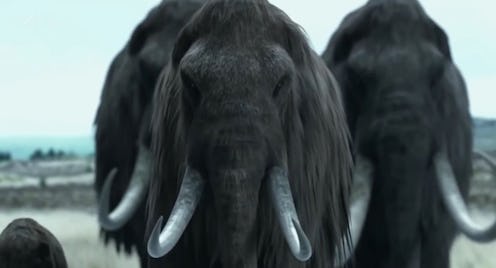News
Will We See A Woolly Mammoth Clone Soon?

As months and years drift by, the scope of possible scientific achievements just keeps broadening, making potential realities out of the improbable, and once-unthinkable. And you can definitely file this story under that category — according to NBC News, scientists believe we're getting closer to cloning a woolly mammoth, the massive, hairy beasts that roamed the Earth throughout its last ice age.
For some perspective, most woolly mammoths had died over 10,000 years ago. There was, however, a small holdout population that survived on a remote island off the coast of Eastern Siberia up until 1650 BC, a far more recent existence than most people tend to imagine.
And even if you're not much of a science or evolutionary history buff, you probably know what these impressive creatures look like. They're some of the most well-documented prehistoric beasts out there, resembling fur-covered elephants with shortened trunks, which helped them survive the brutally cold climate. As NPR detailed on Thursday, researchers have been able to identify similarities between African elephants' DNA and that of the mammoth, thanks in large part to an incredibly well-preserved body discovered in Siberia in 2013. Their subsequent work could theoretically allow them to resurrect the long-extinct species someday — that is, if they wanted to.
According to University of Chicago evolutionary biologist Vincent Lynch, a co-author and leader of the research study, however, that's not the plan. Lynch raised ethical reservations over the idea, in talking to NBC News on Thursday, saying, "It won't be that long till we're technically able to do it, but whether we should is a different question. I don't think we should."
It's worth noting than even if scientists did try to clone a mammoth, it wouldn't be exactly the same creature that died out those thousands of years ago. Rather, it would likely be a mutated version of an African elephant, genetically engineered to assume many key traits of its distant relative. Lynch expanded on this idea further to NPR — acknowledging that mammoths are complex social creatures, he seems to regard cloning one as a likely cruel experience.
You could change this one gene in an elephant and maybe make it woolly mammoth-like with respect to some things. ... And even then it's not really a woolly mammoth. It's a transmutated Asian elephant. You can never actually bring back a woolly mammoth. ... Elephants are intelligent species. They have complex social groups. They learn from each other. So if we bring back a woolly mammoth, who's it going to learn how to be a woolly mammoth from?
These are very humane, important ethical concerns when it comes to cloning any long-dead species, and it speaks well of Lynch (and the scientific community more broadly) that they're being considered. But it's impossible not to think that at some point, someone with the means and the know-how might be enticed to take this plunge.
Images: LLP Science/YouTube